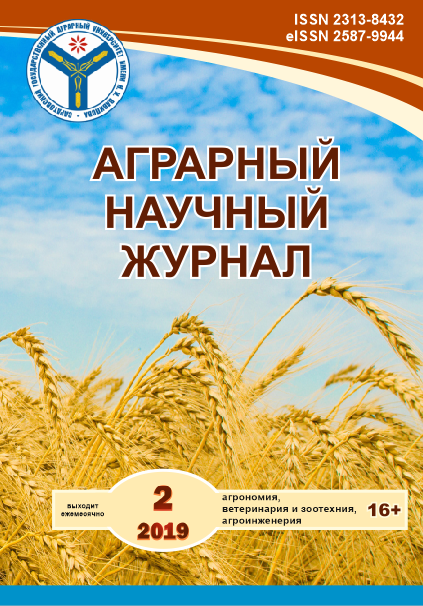Morphological composition of blood and indexes of protein metabolism in dry cows
DOI:
https://doi.org/10.28983/asj.y2019i2pp33-36Keywords:
cows, feed, blood, indicator, metabolismAbstract
The results of a hematological study of cow’s blood are presented, as well as the results of an evaluation of the protein metabolism of serum of dry and newborn cows. The use of various vitamin-mineral premixes (P60-3/2 and P 60-3/P) in combination with and without propylene glycol has been analyzed in animal diets. This research was supported by FASO Russia project АААА-А18-118031390148-1. The methods of morphological investigation of blood, methods of biochemical study of protein metabolism parameters of blood serum, mathematical and statistical methods were used in the work. Studies have established that the use of various feed products in the rations of feeding animals and the various terms of their application have an effect on the morphological and biochemical composition of blood and serum, respectively. Changes are established two weeks before calving and on the third day after calving. The use of the premix P60-3/P in the feeding of animals of the third group throughout the entire dry period in combination with propylene glycol is accompanied by the most pronounced significant increase in erythrocyte content in these individuals on day 3 after calving (by 21.3%, P<0.05 ). Two weeks before calving, the content of serum of total protein (25.2-30.1%, <0.01) and albumins (21.7% (P<0.05) - 52.2% (P<0.01) The use of the third group of premix P60-3/P in the feeding of animals from the first day of the dry period is accompanied by the most pronounced significant increase in the total protein content of these individuals two weeks before calving (30.1% %, P<0.01).
Downloads
References
2. Гильмутдинов Р.Я., Курбанов Р.З. Исследование крови животных: Методические аспекты. – Казань: Изд-во ТГГИ, 2000. – 240 с.
3. Головань B.T., Юрин Д.А., Дахужев Ю.Г. Эффективные элементы технологии выращивания телят-молочников // Политематический сетевой электронный научный журнал КубГАУ. – 2007. – № 31 (7). – С. 162–167.
4. Головань В.Т., Дахужев Ю.Г., Галичева М.С. Разработка производ-ственно-экономических нормативов в молочном скотоводстве // Новые технологии. – 2009. – № 1. – С. 16–20.
5. Жиры в кормлении высокопродуктивных коров / Е.О. Крупин [и др.]. – Казань, 2013. – 108 с.
6. Зарипова Л.П. Корма Республики Татарстан: состав, питательность и использование. – Казань: Фэн, 2006. – 208 с.
7. Крупин Е.О. Влияние корректоров энергетического обмена в комплексе с витаминно-минеральными премиксами на показатели воспроизводства и состояние молочной железы у высокопродуктивных коров // Ученые записки Казанской государственной академии ветеринарной медицины имени Н.Э. Баумана. Казань. – 2010. – Т. 203. – С. 140–144.
8. Методы ветеринарной клинической лабораторной диагностики: Справочник / И.П. Кондрахин [и др.]. – М.: Колос, 2004. – 520 c.
9. Нежданов А., Сергеева Л. Тип кормления и профилактика бесплодия крупного рогатого скота // Кормление сельскохозяйственных животных и кормопроизводство. – 2007. – № 7. – С. 27–29.
10. Овсянников А.И. Основы опытного дела в животноводстве. – М.: Колос, 1976. – 304 с.
11. Применение антиплацентарной крови и препарата «Нитамин» для профилактики задержания последа и субинволюции матки коров / А.Г. Дарменова [и др.] // Аграрный научный журнал. – 2018. – № 9. – С. 15–18.
12. Стрекозов Н.И. Научные основы повышения эффективности молочного скотоводства // Зоотехния. – 2011. – № 11. – С. 12–14.
13. Усович А.Т., Лебедев П.Т. Применение математической статистики при обработке экспериментальных данных в ветеринарии. – Омск: Западно-Сибирское кн. изд-во, 1970. – 43 с.
14. Herdt, T.H. Fatty liver in dairy cows / T. H. Herdt // Vet. Clin. North Am. Food. Anim. Pract., 1998, No. 4, P. 269–287.








